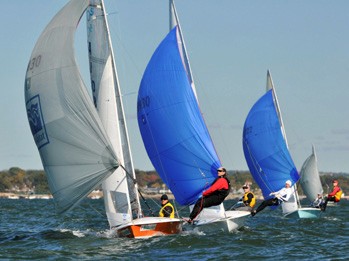By Taylor Martin, Adult Sailing Director, New England Science and Sailing Foundation
 When it comes to racing, so much work is put into figuring out upwind sailing: when to sail through a header, the mythical ‘lee-bow’ effect in current, etc., and the downwind leg is often left to its own devices. Even worse, once many of us round the windward mark, the beer comes out. The downwind has so much potential for gains and losses that even the best of us should spend time working on downwind trim and tactics.
When it comes to racing, so much work is put into figuring out upwind sailing: when to sail through a header, the mythical ‘lee-bow’ effect in current, etc., and the downwind leg is often left to its own devices. Even worse, once many of us round the windward mark, the beer comes out. The downwind has so much potential for gains and losses that even the best of us should spend time working on downwind trim and tactics.
New England Science and Sailing Foundation Sailing Program Director Mark Zagol (helm) and Drew Buttner, winners of the 2015 5O5 Midwinter Championship, demonstrate perfect spinnaker technique. © Allen Clark/PhotoBoat.com
Unless you are sailing in a scholastic program, chances are that you are using a spinnaker on the downwind, either asymmetric or symmetric. Both have their advantages, and each can be tricky in its own way. Even with the increasing prevalence of asymmetricals, most sailors will spend more time on the traditional symmetrical spinnaker, from PHRF cruisers to high-intensity dinghies like 420s or 5O5s.
Symmetrical spinnakers have the advantage of being able to sail deeper downwind angles than can be achieved with asymmetrical spinnakers, especially in lighter breeze. One clear disadvantage compared to asymmetric spinnakers is their complexity.
A successful downwind leg first stems from a change in mindset. For serious racers, the downwind should be as competitive and as much work as the upwind. Once you recognize that you can make massive gains by taking this leg seriously, maintaining focus gets easier. The next step to success is preparation.
Boathandling aside, making sure that all lines for the chute are run correctly, and that it is packed correctly and the pole is on deck ready to go, can make boat lengths of difference at the windward mark. For most windward-leeward courses, the spinnaker should be rigged to launch on the port side, which means that your halyard and sheet will also be on the port side and your pole, topping lift, and downhaul should be on the starboard side. Your guy should be led around the forestay to the port side, where the spinnaker will be set. Making sure that this rigging gets sorted before it’s too late is imperative. If you’re sailing a dinghy, checking your rigging before launching can often shake out any problems before the race. With all boats, getting a chance to run through a set and a douse before the race starts can be instrumental to success.
When packing a spinnaker, making sure that the ‘belly’ or the middle of the sail gets packed first, with the three corners up and out of the bag, will prevent many twists and tangles. The corner that the sheet is attached to should be facing aft and the guy corner should be toward the bow, with the head clear and on top/inboard. Inevitably, despite all your preparations the spinnaker may ‘hourglass’ or twist in the middle but be full above and below the twist. The quickest fix is to briefly lower the halyard 8 to 12 inches, and it should un-twist itself.
Once the spinnaker is up and full, trimming is simply a matter of making sure it stays as square to the wind as possible. You control this with the position of the spinnaker pole. A good general rule is that the pole should be perpendicular to the wind, depending on the type of boat. Vertically, the pole should be adjusted so that the tack and clew of the spinnaker are level. These ‘static’ settings should be adjusted as you change course, the wind shifts, or the velocity changes. Once you are satisfied with these static settings, trimming the spinnaker should be a constant adjustment on most boats. Easing the sheet until the luff curls (between 6 and 18 inches, depending on the size of the spinnaker) and then trimming in slowly is a good place to start. This curl means that the spinnaker’s not overtrimmed, and catching as much wind as possible. The longer you can carry this curl before the chute collapses, the better. Finding this edge is key to downwind speed.
The ability to gybe quickly and keep the spinnaker full takes lots of practice, but having confidence in your boathandling means you can focus on the tactics of the downwind, and take full advantage of the opportunities to pass people. Making sure that you have the time to get on the water with consistent crew will give you the best chance at success on the downwind. Most errors occur during transitions (sets, gybes, douses), so these are the things to practice most. Straight-line speed comes more easily for most people than coordination during the transitions, but is equally as important to work on. Get out in as many different conditions as possible, and figure out what works best for you and your crew.




